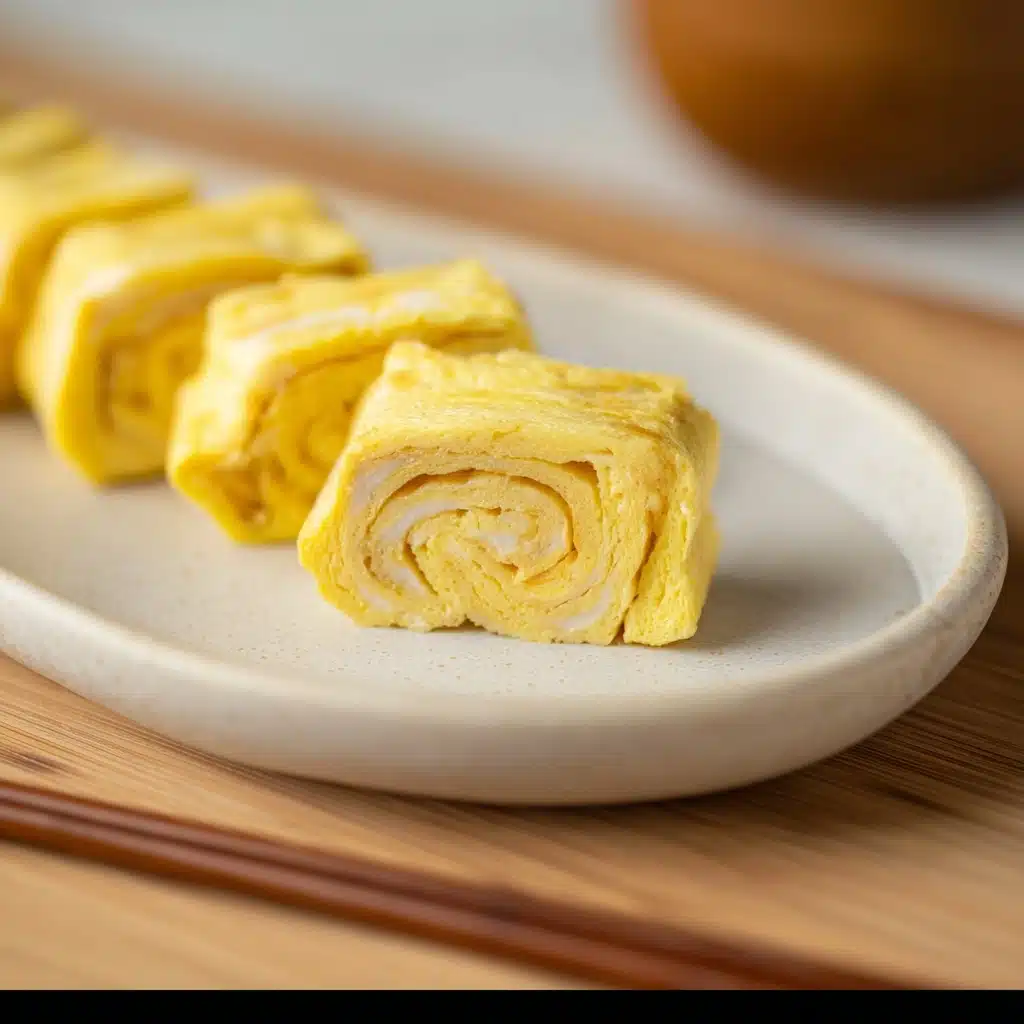If you’ve ever marveled at those perfectly golden, delicately layered slices of Japanese Rolled Omelet in a bento or at a sushi bar, you’re in for a treat! This Japanese Rolled Omelet is the embodiment of comfort—soft, fluffy, just a hint of sweetness, and kissed with umami. It’s not just a breakfast food, but a truly versatile recipe you’ll want to master for snacks, lunchboxes, and even an elegant dinner side. Let’s roll up our sleeves and bring this delightful dish to your table!
Ingredients You’ll Need
The beauty of a Japanese Rolled Omelet is in its minimal ingredient list. Each element has a role—whether it’s lending tenderness, introducing a whisper of sweetness, or offering that signature savory depth. Here’s what you’ll need, plus a tip for each!
- Eggs: The star of the show! For the softest layers, use the freshest eggs you can find.
- Dashi (Japanese stock): This adds a subtle, savory backbone—try instant dashi powder if you’re short on time.
- Soy Sauce: A splash brings balance and a gorgeous golden hue to each roll.
- Sugar: Just a touch gives the omelet its iconic gentle sweetness.
- Mirin: This sweet rice wine rounds everything out with a light gloss—if you don’t have it, a tiny bit of extra sugar works in a pinch.
- Oil (neutral, like canola or vegetable): This will ensure your omelet doesn’t stick and keeps the layers tender.
How to Make Japanese Rolled Omelet
Step 1: Beat the Eggs
Crack your eggs into a mixing bowl. Using chopsticks or a fork, gently beat them until the yolks and whites are just blended—don’t overdo it or you’ll add bubbles, and we want silky smooth layers for our Japanese Rolled Omelet.
Step 2: Mix in Seasonings
To your eggs, add the dashi, soy sauce, sugar, and mirin. Whisk until everything is fully combined. This is where the magic blend of savory and sweet begins to form the omelet’s signature taste.
Step 3: Preheat and Oil the Pan
Heat a rectangular tamagoyaki (rolled omelet) pan or a small nonstick skillet over medium heat. Lightly oil it with a paper towel dipped in oil, making sure to coat every corner. Remember, a well-oiled pan makes all the difference for easy rolling!
Step 4: Cook the First Layer
Pour a thin layer of the egg mixture into the pan, just enough to cover the bottom. Let it set slightly, then carefully roll it up from one side to the other using a spatula or chopsticks. This first roll is your foundation.
Step 5: Add and Roll More Layers
Slide the rolled omelet back to the starting side of the pan. Re-oil the exposed pan, then add another thin layer of egg (making sure it flows under the log you’ve already rolled). When this layer is almost set, roll the omelet again, encasing the first roll in more egg. Repeat until all the mixture is used up, forming a thick, layered Japanese Rolled Omelet.
Step 6: Shape and Rest
Once you’ve finished rolling, gently press the omelet into shape using the spatula or a rolling mat lined with plastic wrap. Rest the omelet for a couple of minutes to let the layers settle; this makes slicing easier and helps the shape hold.
How to Serve Japanese Rolled Omelet

Garnishes
A classic touch for Japanese Rolled Omelet is a dainty mound of grated daikon radish with a little soy sauce drizzle. Sprinkle with finely chopped scallions or nori strips for freshness and a pop of color.
Side Dishes
Pair your omelet with simple steamed rice, tangy pickled vegetables, or miso soup for a wholesome Japanese breakfast experience. Or, slip slices into bento boxes alongside sushi rolls, onigiri, or sautéed greens for variety and balance.
Creative Ways to Present
Experiment by slicing the Japanese Rolled Omelet into tiny squares for skewers, rolling it up with shiso leaves for a herby twist, or even tucking it into sandwiches for a unique, fluffy filling. It’s a dish that loves to play dress-up, so get creative with your presentation!
Make Ahead and Storage
Storing Leftovers
If you find yourself with leftover Japanese Rolled Omelet, store it in an airtight container in the fridge. It will keep for up to two days and is just as delicious cold.
Freezing
For longer storage, wrap cooled pieces of omelet tightly in plastic wrap and freeze. They’ll keep for about a month. Thaw overnight in the refrigerator before using—great for prepping bento lunches in advance!
Reheating
To enjoy warm, reheat the omelet slices gently in a nonstick skillet over low heat, or microwave in short bursts. Try to avoid overheating, which can make the texture rubbery; low and slow is key to preserving that soft bite.
FAQs
Do I need a special tamagoyaki pan for Japanese Rolled Omelet?
A rectangular pan makes the classic look easier, but any small, nonstick skillet will work! You might have slightly rounded ends, but the flavor and fun are just the same.
Why is my omelet breaking or sticking to the pan?
Usually this means the pan wasn’t hot or oiled enough, or the egg layers were too thick. A little patience and keeping each layer thin are the secrets to perfect rolls.
Can I make Japanese Rolled Omelet without dashi?
Absolutely! While dashi adds that signature umami, you can substitute with water for a milder version, or try a light vegetable broth for a different flavor.
Can I add fillings like vegetables or cheese?
Definitely! Finely chopped green onions, delicate greens, or a little shredded cheese tucked between the layers are delicious variations. Just keep additions light so rolling is easy.
Is Japanese Rolled Omelet served hot or cold?
It’s fabulous both ways! Many enjoy it fresh and warm, but it’s a beloved cold snack or bento addition, thanks to its tender texture holding up well at any temperature.
Final Thoughts
If you’ve never tried making Japanese Rolled Omelet at home, you’re in for a rewarding kitchen adventure. Once you’ve tasted those perfectly tender, layered bites, you might find yourself whipping it up for breakfast, lunch, or even a midnight snack. Give it a try—your taste buds (and anyone you share with) will thank you!
Print
Japanese Rolled Omelet Recipe
- Prep Time: 5 minutes
- Cook Time: 10 minutes
- Total Time: 15 minutes
- Yield: 2–3 servings
- Category: Side Dish
- Method: Stovetop
- Cuisine: Japanese
- Diet: Vegetarian
Description
Delicately sweet and savory with silky layers, this Japanese Rolled Omelet is a versatile and comforting dish perfect for breakfast, lunchboxes, or elegant side servings.
Ingredients
- 4 large eggs
- 2 tbsp dashi (or water or light broth)
- 1 tsp soy sauce
- 1 tsp sugar
- 1 tsp mirin
- Neutral oil (like canola or vegetable), for greasing
Instructions
- Beat eggs gently until combined, avoiding excess bubbles.
- Whisk in dashi, soy sauce, sugar, and mirin until smooth.
- Preheat and lightly oil a tamagoyaki or small nonstick pan over medium heat.
- Pour in a thin layer of egg. Once it starts to set, roll to one side.
- Re-oil the pan, pour another thin layer of egg, and roll again, enclosing the previous roll. Repeat until all egg is used.
- Shape with a spatula or mat, let rest for 1–2 minutes, then slice into pieces. Serve warm or chilled.
Notes
- Optional garnishes: grated daikon, soy sauce drizzle, chopped scallions, or nori.
- Try fillings like green onions or shredded cheese for variation.
- Use a rectangular tamagoyaki pan for traditional shape, but any small skillet works.









